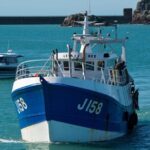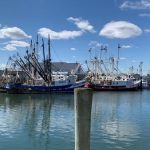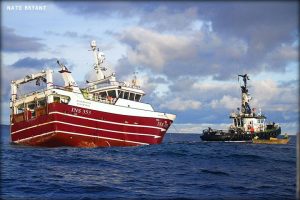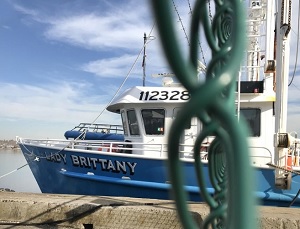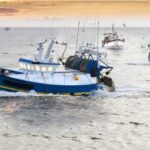Whelk Fishery, Once $6 Mil Now Threatened With Closure By Aggressive Minimum Rules
 Recent Published Science Papers say MDMF Headed in Direction Wiping Out the Species
Recent Published Science Papers say MDMF Headed in Direction Wiping Out the Species
 The sun permanently setting on a near half century old fishery processor in the nation’s lead commercial fisheries revenue port is not a pretty sight to contemplate. But it is real. And contemplated by a significant processor particularly well run key component to the channeled conch fishery supporting dozens of boats in Southern New England waters.
The sun permanently setting on a near half century old fishery processor in the nation’s lead commercial fisheries revenue port is not a pretty sight to contemplate. But it is real. And contemplated by a significant processor particularly well run key component to the channeled conch fishery supporting dozens of boats in Southern New England waters.
New fishing rules increased the minimum legal landing size by 1/8” chute gauge width size bi-annually since 2019, each time reducing the commercial landings by 120,000 pounds—and revenues lost in that time over $500,000.
The next increase is slated for 2023; independent marine economists say “the once $6 million annual fishery will be dropped from the recent annual landings of 806,000 pounds to about 600,000 pounds. Twenty boats will no longer economically function. And the fish processor loading dock will become part time. Or close. Or move out of state where species conservation and scientific awareness, and the fishery economics, will be in far better balance.”
The 1/8” minimum incremental chute gauge size increase was adopted by the MADMF director David Pierce in 2018, well before, and with little regard for, any studied reading of the three major peer reviewed and published scientific papers, based on extensive research of conch in Buzzards Bay, on conch sexual maturity, biology and stock assessment reference points of the channeled conch.
Bahe-Jin Peemoeller of the University of Maryland Eastern Shore in 2013 following two intensive research years in Massachusetts waters; Brad Stevens, following further research in those Massachusetts waters, also of the University of Maryland Eastern Shore in 2015; and Steven Wilcox et al. following his master’s unpublished and non-peer reviewed thesis, a full blown peer reviewed publishing of the same subject, based in part on the Peemoeller/Stevens research, in 2021.
So just what is it that has taken the channeled conch, a sub-tidal snail which maintains a principal market half a world away, from a minor unwanted clam predator of practically no use to serious commercial fishermen, to a vigorously pursued species inviting the intellectual and regulatory wrath of the Massachusetts Division Marine Fisheries.
For one, conch are relatively easy to catch and land. And further, wholesalers will pay upwards of $4 a pound, wet and in the shell. They were not always. As recent as the year 2000 conch could barely fetch $1.00 a pound, and few bothered. Aside from a small ethnic domestic market, conch were destined for Japan and China. Packaging and transportation a half world away eventually made the effort on Nantucket Sound and Buzzards Bay worth it.
Further demise of the lobster fishery especially south of Cape Cod made conch increasingly worth the energy and investment. Conch populate sub-tidal waters worldwide. They have generated interest that produced more than 100 scientific papers, many which have contributed, if only marginally, to the perpetuation of the species, and economic improvement of the fishery.
Notably channeled conch litter the sub-tidal bays, inlets, river mouths, and sounds of the eastern Atlantic states from Massachusetts south to the Florida. Conch, for all the marine research attention generated in the past quarter century, still present a conundrum for fishermen, marine scientists, and state regulators. Conch biologically don’t lend themselves to the conventional marine fisheries regulatory scheme which relies on some relative uniformity of size, shape, maturity, arrival at sexual maturity.
Despite Massachusetts clinging tenaciously to shell size as a means of identifying specimens legally harvestable, scientists who have spent two years handling and studying over 16,000 specimens in Buzzards Bay, say the conch shell is so abnormal in size and shape so as to not lend itself to any standard of measure that would be capable of reliable use for regulatory purposes.
The Buzzards Bay scientists say “channeled whelk have an asymmetrical shell structure, and there is no standard procedure for measuring shell width. Therefore we used lip width because it is more easily replicated and more precise than shell width (Peemoeller and Stevens 2013).”
All rules will have their outliers. Someone will draw the short straw. But in Massachusetts the list of straws to shorten, has gotten wider and far more complex. To the point where some scientists –even ones as well thought of as both Steven Cadrin and Kevin Stokesbury, observe the progressively larger minimum legal landing size will guarantee a much-diminished fishery, one that for many boats and crews will no longer be economically tenable.
Eight years ago, Massachusetts waters were considered to have been substantially swept of the larger conch. Big ones sold better. And for much more money. The bar to picking up just about every hefty sized conch was minimal at best. Trap limits were possession of 200; and the minimum legal size was set, not the by MADMF, but by the processors. If the fishery was not depleted, it certainly seemed headed that way.
It was the regulatory problem worldwide.
How do you appropriately balance a species adequately replenishing itself while assuring a continuing robust fishery? Especially when it is so easily fished of a species so slow to mature. And as if that were not a sufficient problem in and of itself, the species is so localized it does not spawn in a neighboring bay. They barely move yards from where they start their lives.
The paltry restrictions on the conch catch hardly slowed the annual landings which reached over 3 million pounds. The fishery would not fail to cast a blind eye at the trucks hidden in the saw grass to take on loads of hundreds of pounds of conch, few if any reported, headed with certainty to East Asian exports. That market certainly drove this bus.
David Pierce, then the director of the fisheries division, was prodded to seek a remedy for an overfished sitting duck. Its dubious value emerged when the lobster fishery south of Cape Cod crashed prompting that near shore fleet to use its similar traps and familiar waters to land conch. Readily available and with the price per pound rising above $1, wet and in the shell, the fishery saw an influx of fishers certainly capable of exacerbating the pressure on the fishery.
Stevens noted “the ‘conventional’ management philosophy at the time (and which is still applied to conchs) was to protect the juveniles by creating minimum size limits (MSL). It is only more recently, since 2010, that scientists have begun to realize that the ‘big old fat fecund females (BOFFFs) are the most important part of the population because they produce most of the reproductive effort. And the best way to protect them is to institute MAXimum size limits, i.e. require fishermen to throw back the largest females.
This occurs to some degree in the lobster fishery (but only if they are actually carrying eggs) but is required in some finfish fisheries. I suggest we should do the same for conch.” Brad Stevens and Bahe-Jin Peemoeller at the University of Maryland Eastern Shore completed conch research in Massachusetts waters in 2013 and published two peer reviewed papers on conch maturation and growth in 2013 and 2015.
In 2009 MADMF received a petition from conch fishermen on Martha’s Vineyard to increase the minimum legal size shell width from 2 ¾” to 3”. Steve Wilcox said “there was no scientific literature to support a biological basis for increasing the minimum size” The MADMF trawl survey of conch to begin to determine the size and age at sexual maturity was commenced in 2010 with Commercial Marine Fisheries Foundation funding. Sampling occurred in Buzzards Bay, Vineyard Sound and Nantucket Sound, predominant conch fishing grounds.
At the Massachusetts Division of Marine Fisheries invitation, the Massachusetts Conch Association members, some seven active near shore fishermen showed up at a December 2021 meeting, at the request of the new division director to further discuss the regulatory shaping of this small but vibrant fishery.
Dan McKiernan, the director, and a veteran division professional staffer, and Robert Glenn rolled through an informal agenda speaking to several rule issues. One was the experience in the field fishermen were having with the new three-sided aluminum chute through which legal animals would attempt to pass to determine “keepers”—fish that would be legally landed and sold in Massachusetts.
“Shells in nature are irregular shaped” and such anomalies can allow an otherwise “legal animal” to fall through the chute, such ending up being falsely labeled “illegal and undersized” when they are not. Glenn acknowledged the gauge as being less than perfect, but protested it as being a useful and somewhat reliable tool.
McKiernan acknowledge the problem, suggesting still that experienced fishermen would know and recognize a legal size.
A handout provided by the division traced the landing weights over more than a dozen years. The year 2021, still being calculated, showed the fishery landed 850,000 live pounds in the shell sold at $4 live in the shell. Still that statistic was only 25% of that landed in 2014 – a drastic drop in productivity with the current landing value at just over $4 a pound live in the shell.
One fisherman noted that the $3 million revenue still does not justify the current increased minimum size primarily responsible for driving down the gross landings weight. More than a decade ago CONCH were seen largely as a nuisance species which preyed on clams, barely fetching $1 a pound. Asian tastes largely sought out the species for exotic dishes. Then market tastes and opportunity changed. Massachusetts just happened to have the most bounteous growth of channeled whelk on the East Coast.
The Regulatory History In 1992, with the Baystate tidal waters littered with the conch, attracting a fair amount of attention, the regulators adopted a 200-conch trap limit. That was followed by a closed season from December 15 through April 15 the following year. Six years later, by 1998 trap tags were required: 220 tags would be issued to a licensed fisherman.
Eventually, in 2014 tags were required to be placed on gear before the season started. Within two years the tag limit was increased to 240. The time of day when traps could be tended was restricted to daylight; just before sunrise to one half hour after sunset traps would be pulled, set or tended. In a further effort to restrict the fishery, admittedly in an ad hoc fashion, was the proposed rule to eliminate the late summer fishing season; it failed.
Parallel to licensing and trap limits was the early effort to constrain fishing by attempting to set a minimum size. By 2005, a little more than a decade into this growing but limited interest fishery, landings of live in shell conch had risen to 1,354,821 pounds attracting $1.07 a pound in the shell ($1.54 in 2022 dollars). It produced $1,454,295 in revenue to the fishermen.
The initial effort to set a minimum size was a shell width of 2 ¾” prompted largely by commercial needs, not biological evaluation. A chute-guage was employed as an enforcement device, required on all boats. By 2014, after two 1/8 inch increases over past two years, the minimum legal landing size was 3 inches. This period would represent the apex of landings volume and revenue with over 3,500,000 pounds live in the shell conch landed, yielding $6.25 million landing revenue for fishermen. 2022 dollars would produce $7,500,000.
The party was over.
Had they been able to continue fishing at that value for similar landings in 2022 the yield would have annually produced over $8,400,000. Further constraints were adopted for use in the chute; the conch had to not slide through in any orientation. Given the natural irregularity in any conch shell, slight narrowing of an otherwise legal sized shell could easily make it illegal to land. Fishermen say “such a rule change is tantamount to a minimum size increase unfair. Particularly if the conch is fed straight on into the chute and it satisfies the width dimension that way.”
That rule, seemingly artificial in the view of some, effectively would strip another $75,000 to $100,000 out of landings values, for no purpose at all. In May 2019 a public hearing was held in an effort to adopt a new fishery management plan that would stanch any further depletion of conch over the next decade. Its statement of the problem, presented in stark daunting terms, crafted by David Pierce, then then director of the MADMF, said ”At current minimum legal size no female conch are mature.” It continued saying the trawl survey trends were declining and there was a rapid escalation of catch and effort.
This statement was made by the MADMF even though the landings in 2017 were barely over 1 million pounds, over 2 million pounds LESS than that landed in 2012 and a trending downward of landings since that peak.
The government document further stated that the biomass, based on trawl surveys and sampling showed a statistical case the species was overfished. No models for use in the statistical analysis were offered. Not only were the species overfished by the government’s view, the level of fishing going on was also engaged in overfishing, even though there were no catch limits as existed in other conch fisheries, the fishery generally abided by the minimum legal landings size, and the biomass allowed a determination of what overfishing was, but not used by the government.
A college graduate with a BS in marine science was put to work with three others to write a paper that would illuminate the biological state of the fishery. Steve Wilcox, working toward a master’s degree, participated in surveys and analysis of conch, a significantly understudied and little understood shell species world-wide, which would form the basis of the David Pierce ten year schedule of increased minimum sizes of landed conch.
Conch are sedentary, living most of their lives within less than a mile of where they were born, usually in shallow rivers and bay waters on the Atlantic coast. They are biologically distinguishable and can vary in size from one fishing area to another close by. Even though sexually mature whelk can vary in size by more than 15 percent David Pierce settled on a single average size in setting his minimum average legal landing size based on his sampling of females; males on average are typically smaller and so are less likely, no matter how mature, to satisfy the minimum legal size rule.
Stevens, Peemoeller View Mass Rules Bradley Stevens and Bhae-Jin Peemoeller at the University of Maryland completed research on conch in Massachusetts waters, publishing a formal paper in 2016 recognizing the exposure of the species to overfishing because of their sedentary lifestyle, ease of targeting and fishing, and slow growth at maturity.
The paper noted a variety of methods for fisheries regulation that would protect against overfishing and depletion of the species. Steven’s and Peemoeller’s own language is deserving of speaking for itself, especially given the high regard Steven Wilcox and Dan McKiernan have shown for their work.
Increasing the minimum size limit will result in a fishery that almost exclusively targets mature females. Consequently, it may be prudent to consider alternative management strategies such as slot limits, limits on landings, or individual quotas. An inherent but rarely stated assumption of conch management is that all small conch (ie. those below the minimum size limit) will eventually grow to become large conchs if they are not captured. If growth rates differ between sexes, however, then only a small fraction of small conchs (i.e. females) will eventually grow past a certain size, and targeting of larger conchs by the fishery will lead to depletion of females, relative to males. This phenomenon would require different approaches for managing male and female conchs.
Effective management of S type fisheries can best be achieved by using appropriate incentives (rights-based management), participation of fishers in management (including monitoring and decision making), and social group enforcement. States are understandably reluctant to impose new management regimes, but with the participation of fishers, it should be possible to establish experimental management within a restricted portion of the conch fishery so as to determine whether alternative management practices provide an improvement over traditional method.
Considering the sobriety of these respected researchers’ advice, at minimum it would be useful to face the reliable scientific conclusion that, continuing the current regime, “. . . targeting of larger conchs by the fishery will lead to depletion of the females, relative to males.”
Unless that is really what the Commonwealth has in mind.
Dan McKiernan has been formally asked to extend by one year the imposition of an increase in the minimum legal size for channeled conch. The request was made by the nascent Massachusetts Conch Association. The request was prompted by looking at the practical result of the imposition of the two previous years’ increases—over a million dollars revenue lost and landings severely restricted. The fishery was now at 30 percent landings over five years ago. And with one more legal limit increase, even 1/8”, the fishery would be on the verge of closing as it would be uneconomical at that low level of landings.
He has expressed doubts he would support the request, even if it were to review the efficacy of the current rule. Other fisheries regulatory bodies typically perform such review as a routine matter even after one or two years when the shape of the fishery shows stress of some kind. The reduction of the Massachusetts conch fishery has lost over 2/3 of its production—stress by any definition.
Oddly, Dan disclosed his likely official view even before it was presented to the advisory commission, however perfunctory that might be, demanding to know just what kind of scientific review the fishing association was seeking. •

































